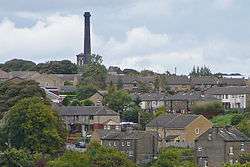Queensbury, West Yorkshire
| Queensbury | |
 Queensbury and the chimney of the former Black Dyke Mills |
|
 Queensbury |
|
| Population | 16,273 (Ward.2011) |
|---|---|
| OS grid reference | SE105311 |
| – London | 175 mi (282 km) SE |
| Metropolitan borough | City of Bradford |
| Metropolitan county | West Yorkshire |
| Region | Yorkshire and the Humber |
| Country | England |
| Sovereign state | United Kingdom |
| Post town | BRADFORD |
| Postcode district | BD13 |
| Dialling code | 01274 |
| Police | West Yorkshire |
| Fire | West Yorkshire |
| Ambulance | Yorkshire |
| EU Parliament | Yorkshire and the Humber |
| UK Parliament | Bradford South |
| Councillors | Lynda Cromie [1] (Independent [2]) |
| Paul Cromie [3] (Independent [2]) | |
| Michael Walls [4] (Conservative) | |
Coordinates: 53°46′06″N 1°50′43″W / 53.768333°N 1.845278°W
Queensbury is a village in the metropolitan borough of Bradford, West Yorkshire, England. Perched on a high vantage point above Clayton and Thornton and overlooking Bradford itself, Queensbury is one of the highest parishes in England, with fine views beyond the West Yorkshire conurbation to the hills of Brontë Country and the Yorkshire Dales to the north and north west. It has a population of 8,71,[5] being measured at 16,273 in the 2011 Census.[6]
Queensbury is most famous as being the home of Black Dyke Mills, and the Black Dyke Band.
History
Queensbury was originally known as Queenshead. That name was derived from a local pub (still existing) which was popular with travellers on the pack horse route from Halifax to Bradford.
The village was historically divided between the township of Clayton in the parish of Bradford, and the township of Northowram in the parish of Halifax, both in the West Riding of Yorkshire.[7] It became a separate civil parish and urban district in 1894. In 1937 the civil parish was abolished, and the urban district was merged into the new Queensbury and Shelf Urban District. In 1974 the urban district was split, and Queensbury was transferred to the City of Bradford in the new county of West Yorkshire.
Ward
Queensbury Ward is a Ward in Bradford Metropolitan District in the county of West Yorkshire, England, named after the village of Queensbury around which it is drawn. It includes the villages of Clayton Heights and Horton Bank Top as well as several hamlets: Ambler Thorn, Calder Banks, Catherine Slack, Hazel Hirst, Hunger Hill, Little Moor, Mountain, Old Dolphin, Scarlet Heights, Shibden Head and West Scholes.
Black Dyke Mills
Black Dyke Mills was built from 1835 onwards by John Foster as a wool spinning and weaving mill specialising in worsted and mohair fabric, and by 1851 dominated the town. John Foster & Son, the owners of Black Dyke Mills, were responsible for the construction of many of the buildings in and around Queensbury, each being for the benefit of the employees, be it housing/accommodation, shops and leisure facilities. In 1891 the company erected the Victoria Hall in Queensbury for the benefit of its workers and the local community - it had a concert hall, with gallery to seat 650 people, library, billiard room and many other facilities. It also sponsored the internationally famous Black Dyke Mills Band.
The mill has now been converted into individual business units. The company now manufactures elsewhere in the area.
Transport
Three railway lines once converged on Queensbury, one from Halifax, Keighley and Bradford each, known as the Queensbury Lines, all belonging to the Great Northern Railway (later the LNER). Where they met was located Queensbury station, which famously consisted of continuous platforms on all three sides of a triangular junction, an uncommon layout in Britain (the only other example was Ambergate, on the Midland Railway in Derbyshire).
A short distance from the station on the Halifax line was Queensbury Tunnel, 2,541 yards (2,323 m) in length (the second longest on the Great Northern system after Ponsbourne Tunnel in Hertfordshire), while close by on the Bradford line was Clayton Tunnel at 1,057 yards (967 m). All these lines were closed to passengers in May 1955, later to freight in the 1960s, before finally closing to all traffic in 1972-4.
The main Bradford to Halifax road A647 road runs through the village as well as the A644 road. These roads intersect at the Albert Memorial. A regular bus service, First 576, runs through the village between Bradford and Halifax along the A647 road.
Gallery
.jpg) Black Dyke Mills
Black Dyke Mills.jpg) Sunset over Queensbury in September 2010.
Sunset over Queensbury in September 2010.
See also
- Black Dyke Mills Band
- John Foster - founder of Black Dyke Mills
- William Foster - John Foster's grandson
- Queensbury School
References
- ↑ "Queensbury Ward Election Results 2011". City of Bradford Metropolitan District Council. Retrieved 22 June 2011.
- 1 2 "Paul and Lynda Cromie stand down for 'personal reasons'". Telegraph and Argus. Retrieved 22 June 2011.
- ↑ "Queensbury Ward Election Results 2010" (PDF). City of Bradford Metropolitan District Council. Retrieved 22 June 2011.
- ↑ "Queensbury Ward Election Results 2008" (PDF). City of Bradford Metropolitan District Council. Retrieved 22 June 2011.
- ↑ "Census 2001 : Urban Areas : Table KS01 : Usual Resident Population". Office for National Statistics. Archived from the original on 16 August 2009. Retrieved 26 August 2009.
- ↑ "City of Bradford ward population 2011". Neighbourhood Statistics. Office for National Statistics. Retrieved 21 February 2016.
- ↑ Vision of Britain website: Queensbury, West Riding
External links
| Wikimedia Commons has media related to Queensbury, West Yorkshire. |
- Queensbury Directory: community news and business directory
- Queensbury at DMOZ
- Queensbury railway station
- Black Dyke Mill Band
- John Fosters/Black Dyke Mills History
- Queensbury School
- Queensbury Juniors ARFLC
